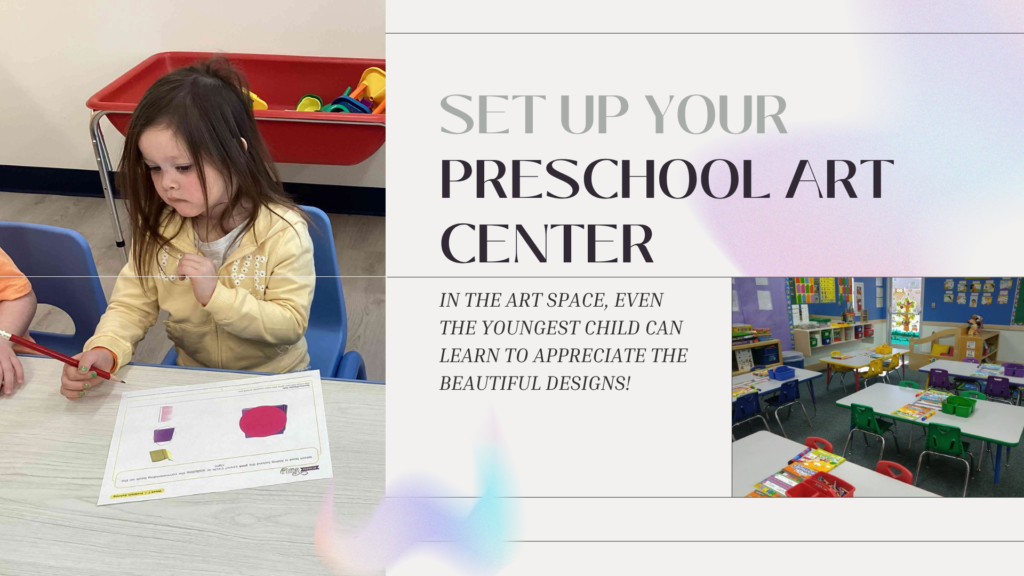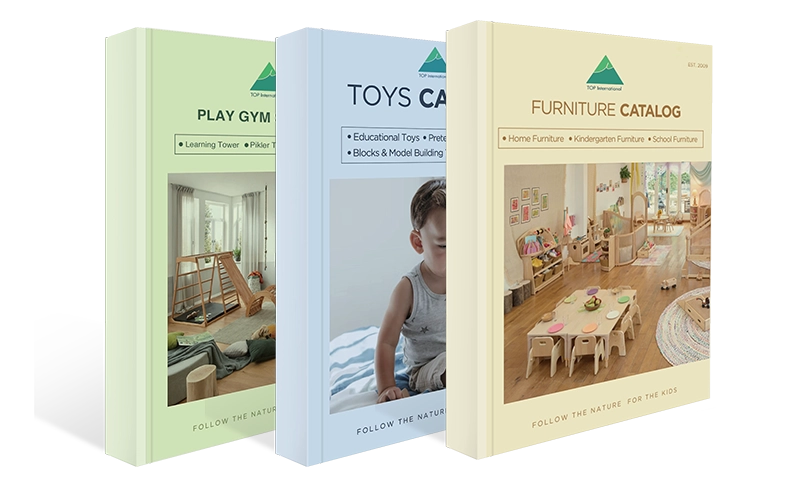Are your art supplies always a mess? Are the kids bored with the same old crayons and paper? Do you want to create a Preschool Art Center that works and excites children every day?
A Preschool Art Center should be more than a corner with coloring books. It’s a space where children cut, paint, glue, and build with purpose. A well-set art area lets kids enjoy materials in their way, while also building skills like focus, creativity, and hand coordination. Whether you’re running a kindergarten or furnishing a new classroom, the way you set up your art center will make all the difference.
Kids don’t need fancy tools—they need the right ones. And they need a space that feels just right for making a mess, having fun, and showing what’s in their hearts. This guide will show you exactly how to set up your Preschool Art Center so your classroom turns into the most colorful, happy place in the building.
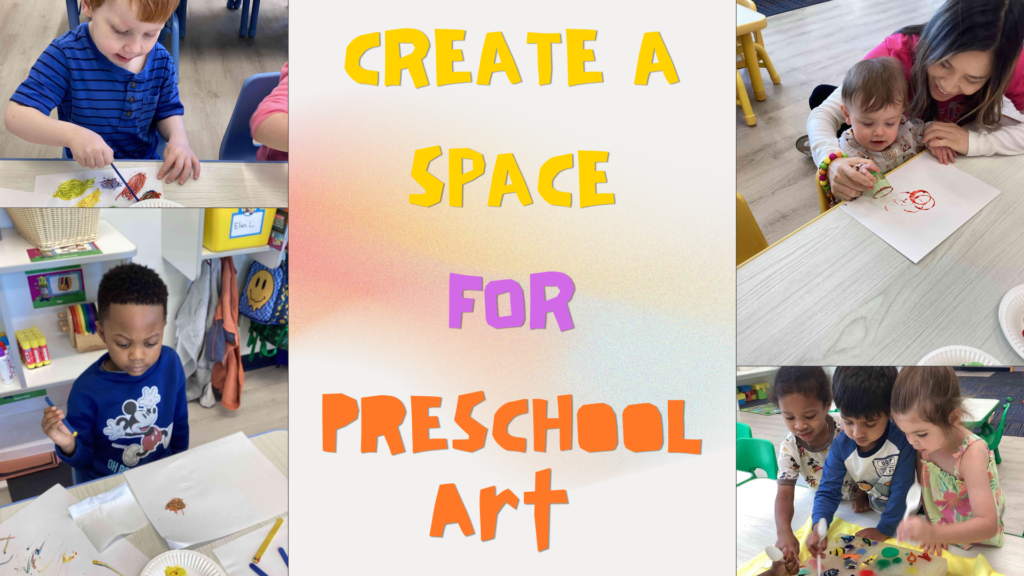
What is the Art Learning Center?
An Art Learning Center is a dedicated area in a preschool classroom where children can freely engage in creative, hands-on activities using a wide variety of materials. It’s not simply a table with markers or a shelf full of coloring books. Instead, it’s a carefully arranged space designed to encourage expression, focus, and individuality through open-ended art projects.
In a well-organized Preschool Art Center, children can paint with brushes, use sponges, tear paper, model clay, and try dozens of other tactile experiences. This space allows them to try out tools and materials at their own pace, without the pressure of perfection. It becomes their little studio—one where there’s no right or wrong way to create.
What makes the Art Learning Center unique is how it blends creativity with early childhood development goals. While children are painting, gluing, or cutting shapes, they’re not just “doing crafts”—they’re also building fine motor skills, making visual decisions, and learning to follow multi-step processes. The beauty of this center is that children are learning deeply while feeling like they’re simply having fun.
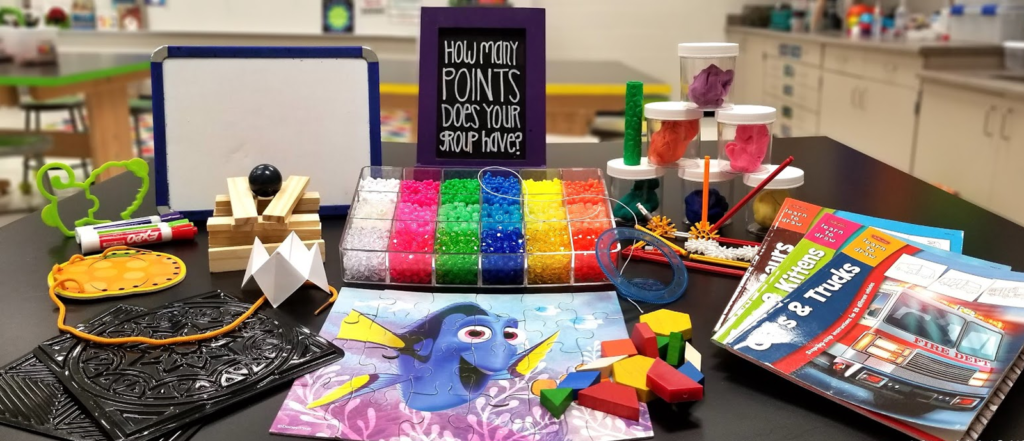
Benefits of a Dedicated Preschool Art Center
Builds Motor Skills
In an art center preschool, children work with their hands in ways that strengthen fine motor control. Tasks like cutting with scissors, painting with brushes, and rolling modeling clay engage the small muscles in their fingers and wrists, crucial for later skills like handwriting and buttoning shirts. Especially in a daycare for children with limited motor skills, the art area preschool becomes more than just a fun corner; it’s a space that actively supports developmental progress. When kids grip a crayon or push down on a glue stick, they’re not just making something pretty—they’re improving control, endurance, and coordination in ways that feel playful, not forced.
Supports Self-Expression
A preschool art center gives young children a powerful outlet for their thoughts and emotions, especially when they don’t yet have the words to explain how they feel. Through color, texture, and imagery, kids can communicate joy, sadness, or excitement. Even something as simple as a child choosing to draw a castle, a donkey, or a real apple reflects personal interests, moods, or memories. In this creative zone, a shy child might draw a house with lots of people, while another experiments with bold lines and bright colors. That’s not just art—it’s personal storytelling. Having an art center in preschool helps every child feel heard, valued, and respected for their ideas.
Boosts Social Skills
The art center for preschool isn’t just a creative outlet—it’s a social hub. Kids naturally talk while they work, ask questions like “How do you draw grandpa?” or “Can I use the red marker after you?” These interactions teach turn-taking, problem-solving, and respectful communication. In a shared space like an art center pre k classroom, children also begin to collaborate, help each other, and offer compliments like “That’s a cool Iron Man drawing for kids!” These soft skills are just as critical as academic learning. The social development that happens around an art table often lays the groundwork for stronger friendships and smoother group dynamics later in school.
Encourages Decision-Making
An effective pre-k art center is all about choice. Kids choose materials, colors, and tools. They decide what to make, how big or small to go, and when a piece feels “done.” Even choosing between making a castle picture to draw or a little girl drawing easily is a valuable act of personal agency. These everyday creative decisions foster independent thinking, build confidence, and support cognitive flexibility. When children are allowed to think through their art projects on their own, they start to trust their instincts. That independence will serve them well not only in future academic tasks but in life overall.
Connects to Other Subjects
Art doesn’t stand alone—it connects beautifully to math, science, literacy, and even social studies. In the art center preschool setup, children might draw numbers 1 to 100, build 3D shapes from recycled materials, or illustrate a scene from a story they just read. Creating a simple drawing of an apple can lead to conversations about taste, texture, or the parts of a fruit. Drawing a police officer, a teacher, or a housekeeper is an easy drawing that ties into community helper units. When children work in the art center in preschool, they’re not just creating art—they’re reinforcing what they’re learning across the curriculum, in a memorable and hands-on way.
Setting Up Your Preschool Art Center
Before You Begin
Before setting up your preschool art center, take a moment to consider a few essential factors. These early decisions will make your setup smoother and more effective.
- Age of Students
Younger children need large, easy-to-handle tools like chunky crayons and glue sticks. Older preschoolers can use scissors, watercolor trays, and follow simple prompts like how to draw a donkey. - Classroom Size
Your space will determine how many children can work in the art center preschool at once. Small rooms may need a rotation schedule, while larger ones can support multiple stations. - Seating Options
Will students sit at tables, on the floor, or use cushions? Flexible seating helps children stay comfortable and focused during creative time.
Planning these basics first helps ensure your preschool art center is safe, accessible, and truly child-centered.
Choosing the Right Location
The location of your preschool art center plays a significant role in how smoothly it runs. Choose a space that’s easy to access, easy to clean, and far enough from quiet zones like reading corners or nap areas.
A few tips when selecting your art center area:
- Near a Sink if Possible
Proximity to water makes cleanup faster after painting or messy craft work. - Good Lighting
Natural light is ideal, but bright overhead lights work too. Kids need to see the colors and textures they’re working with. - Defined Boundaries
Use rugs, shelving, or furniture placement to separate the art center preschool area from the rest of the classroom. This helps children stay focused and reduces the spread of materials. - Avoid High-Traffic Areas
Keep your art center away from busy classroom walkways to minimize distractions and accidents during creative work.
Choosing the right spot ensures your preschool art center supports creativity without disrupting other areas of learning.
Gathering Center Materials
When planning your preschool art center, it’s essential to choose materials that are reusable, durable, and easy for children to handle independently. Reusable supplies save money over time and reduce waste in the classroom. A well-stocked art center in preschool should have a variety of open-ended materials that support creativity, fine motor development, and hands-on exploration.
Here are essential items to include in your pre k art center setup:
- Markers
- Crayons
- Colored Pencils
- Scissors
- Glue Sticks
- Liquid Glue
- Construction Paper
- Drawing Paper
- A Bin of Scrap Paper
- Paint Cups
- Paint Brushes
- Watercolor Trays
- Containers of Craft Supplies
- A Drying Rack
- Smocks
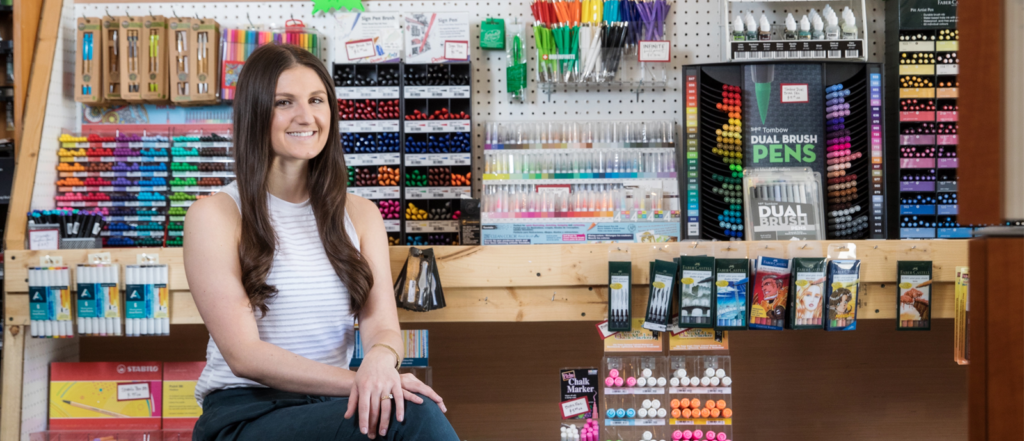
To maximize engagement, keep materials visible and easy to access. Use clear plastic bins, trays, or labeled drawers for organization. Rotate specialized supplies and add seasonal or themed prompts.
Organizing Your Materials
If your pre k art center has clear systems in place, your students will be more independent and responsible. A messy shelf leads to lost supplies, wasted time, and frustrated kids. Here’s a simple way to keep things under control:
- Label with Pictures + Words
For non-readers, pictures are key. Label bins with visuals for scissors, crayons, glue, etc. - Use Shelving Strips or Zones
Assign shelves or bins to each activity. For example, drawing materials in one area, painting tools in another. - Use Hanging Clip Bags
Save shelf space by hanging zippered bags with paper pieces, stickers, or pencil simple easy drawings.
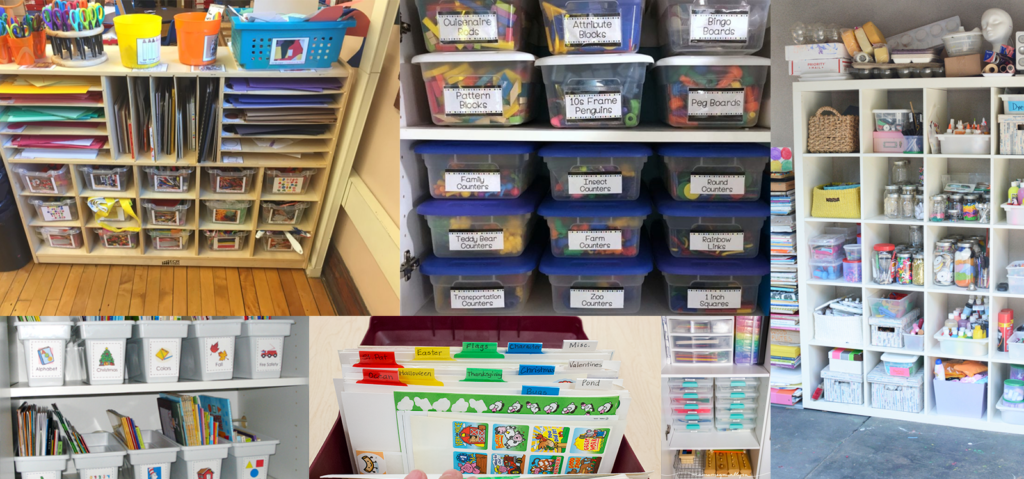
Furniture Matters
The foundation of any effective pre k art center is sized correctly, functional furniture. When the layout supports independence, safety, and creativity, the art center becomes a space children can truly take ownership of.
Here’s what to consider when selecting furniture for your preschool art center:
- Child-Sized Tables
Choose tables that are low to the ground and wide enough for multiple children to spread out their materials—whether it’s drawing paper, paint cups, or collage items. - Supportive Chairs
Chairs should match the table height and provide back support while allowing children’s feet to rest flat on the ground. Avoid adult-sized furniture that limits comfort and independence. - Lightweight and Easy-to-Clean Surfaces
All surfaces should be easy to wipe down. Lightweight materials make it easier to rearrange or clean between sessions. - Standing Easels
Add at least one vertical easel to your setup. Standing easels encourage gross motor movement and support shoulder and arm development through vertical drawing or painting. - Dedicated Work Zones
If space allows, divide areas for specific activities—one zone for painting, one for cutting and gluing, another for drawing. This creates order and focus. - Flexible Seating Options
Incorporate floor cushions or stools for stations that don’t require back support. Giving children a choice in how they sit can improve comfort and focus.
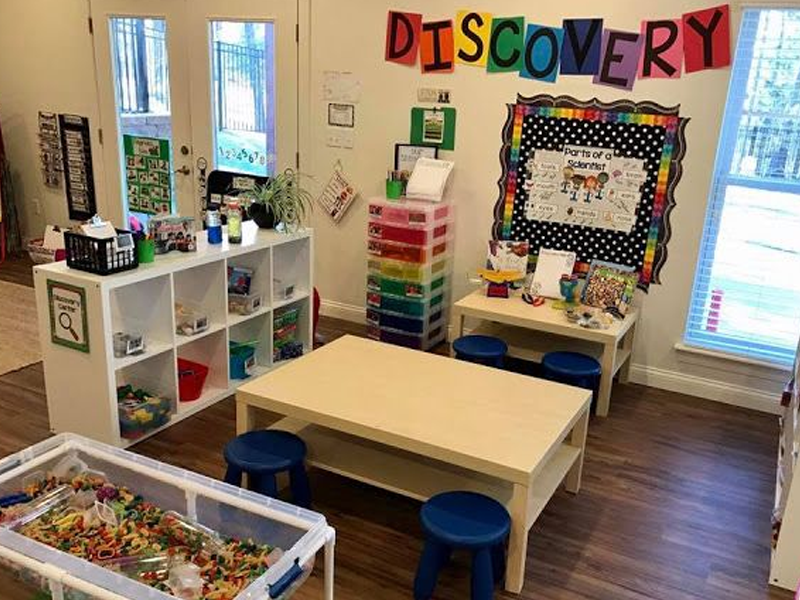
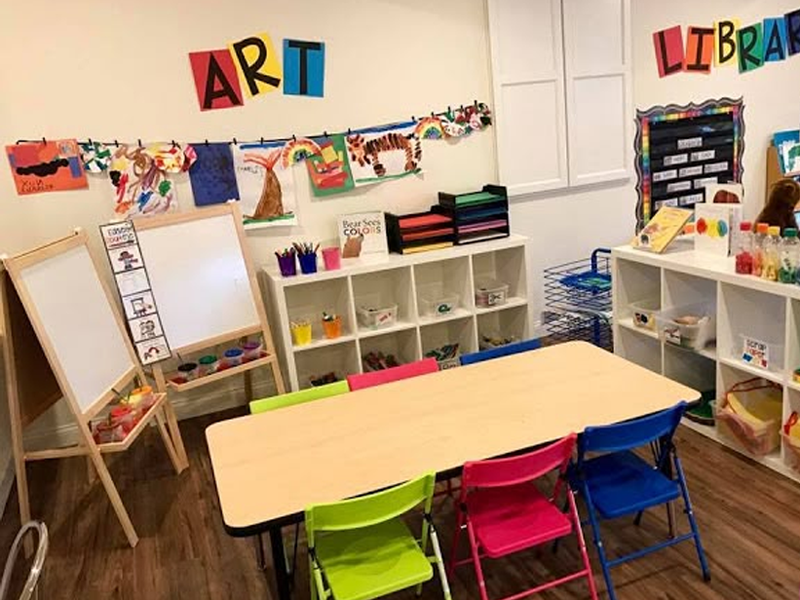
At TOP Montessoris, all our art center furniture is designed with these principles in mind—low height, rounded edges, easy-clean surfaces, and flexibility to fit any classroom layout. The proper setup encourages independence, supports safe movement, and makes daily routines more efficient for both children and teachers.
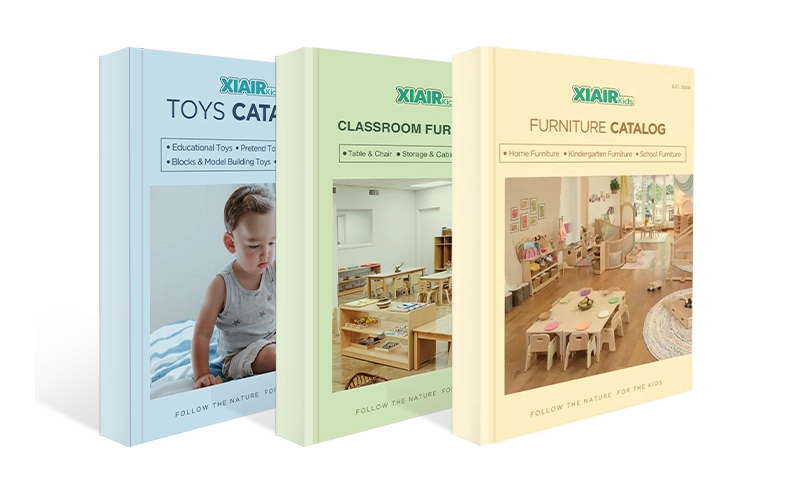
Receive a free catalog and custom layout to help you design your ideal classroom easily.
Tips for Creating an Outdoor Art Space
Adding an outdoor art space to your program gives preschoolers a whole new world to work in—one where fresh air, natural light, and open-ended inspiration are part of the process. Whether you have a large yard or just a small patio, even a simple setup can bring big benefits. Outdoor environments are ideal for messy projects, group collaboration, and nature-based creativity.\
Use Durable, Weather-Resistant Furniture
When building an outdoor art center for preschool, choose furniture made for outdoor use—preferably plastic, coated metal, or treated wood. These materials stand up better to the sun, wind, and water. Low, stable tables and benches are great for group work. If you’re short on seating, plastic crates or mats can offer quick solutions. The key is to keep everything low to the ground and child-sized, just like your indoor pre-k art center.
Set Up with Portability in Mind
Outdoor setups need flexibility. Instead of fixed shelves, use rolling carts or plastic bins with handles to move materials in and out of the classroom. Stackable trays or toolboxes work well for storing art materials for preschool, like brushes, water cups, glue sticks, and paper. Portable easels or clipboards make it easy to draw anywhere, even while sitting in the grass. Bonus tip: Keep a large bucket nearby for dirty brushes or used smocks.
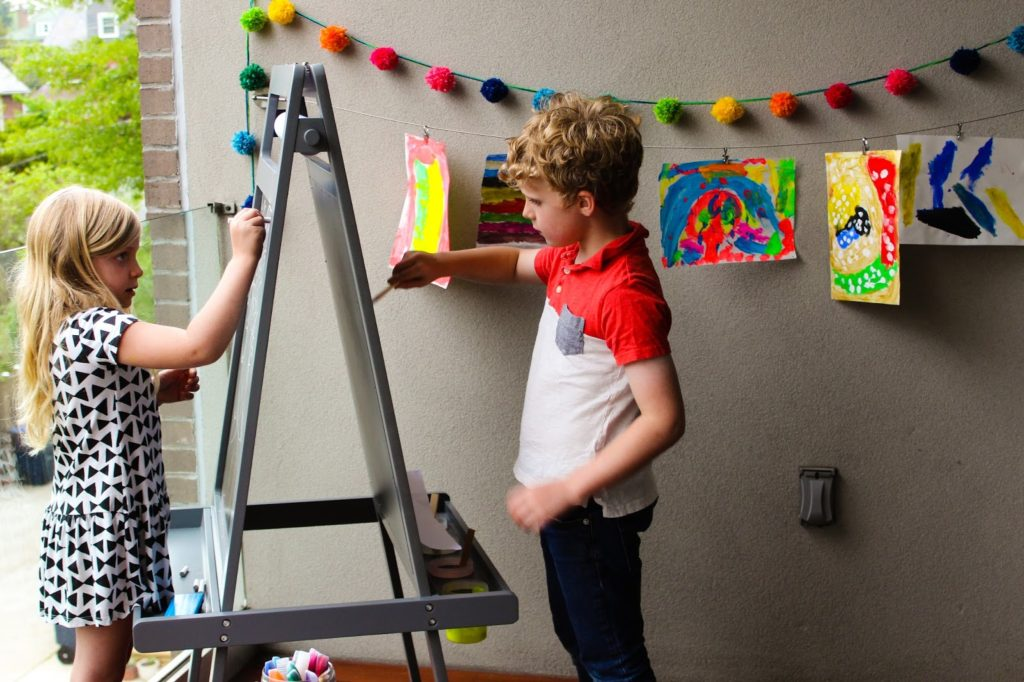
Plan for Messy Projects
The beauty of an outdoor art center preschool is that it can handle the mess. This is the perfect place for splatter painting, clay sculpting, and even group mural work. Use large drop cloths or tarps to protect surfaces, and keep a hose or water bucket nearby for fast cleanup. Some fun outdoor-friendly projects include:
- Nature rubbings using leaves and bark
- Painting rocks or wooden blocks
- Creating collages with natural items
- Drawing with sidewalk chalk
- Trying themed activities like how to draw a pigeon, or easy picnic drawing
Offer Natural Inspiration
One of the most significant advantages of outdoor art is access to real-world inspiration. Children might sit under a tree to draw it, or use fallen leaves in a collage. Prompt them with questions like “Can you draw what the sky looks like today?” or “What colors do you see in that flower?” You can also link the preschool art center to your classroom themes by incorporating drawing prompts like:
- How to draw a donkey after a farm field trip
- Animal drawings in pencil are easy after nature walks
- Cute, easy butterfly drawing after learning about insects
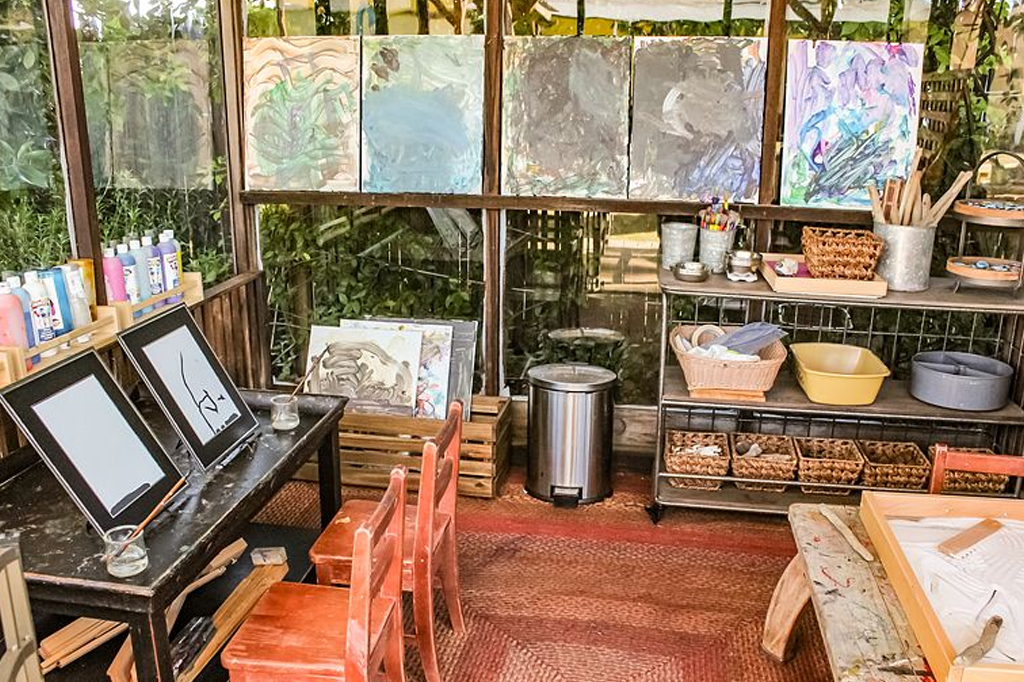
Ensure Safety and Shade
Make sure the outdoor art area is in a safe, enclosed space. Provide shade using tents, canopies, or natural cover like trees to prevent sunburn or overheating. Keep water bottles nearby, and make sure students wear hats or smocks when needed. Store materials in sealable containers to protect them from rain or dust when not in use.
Create an Outdoor Drying Zone
Set up a clothesline or portable drying rack where kids can hang wet paintings or collages. You can also repurpose wire fencing, mesh panels, or string tied between poles. Kids will enjoy seeing their work flutter in the breeze—and it helps teach patience as they wait for their artwork to dry before taking it home.
Creating an outdoor art area for preschoolers doesn’t require a massive budget—just thoughtful planning. The combination of open space and creative freedom can bring out a different side of every child. With the right tools and routine, your outdoor art center can become one of the most-loved areas in your entire program.
General Preschool Art Center Ideas
A well-designed preschool art center should offer more than just crayons and paper—it should spark curiosity, support independence, and give young learners the tools to bring their ideas to life. The best setups balance structure and flexibility, offering enough direction to guide creativity without limiting it. Whether you’re designing a new space or refreshing an existing one, here are some proven ideas to take your preschool art center to the next level.
Rotate Themes Weekly
One way to keep your preschool art center exciting is to introduce weekly or bi-weekly themes. These can be based on seasons, classroom topics, or even student interests. For example:
- Farm Week: Add straw, brown paper, and templates for how to draw a donkey or simple animal drawings
- Space Week: Include black construction paper, metallic markers, and stencils for rockets and stars
- Feelings Week: Offer self-portrait prompts like drawing of a man and a woman or how to draw grandpa, encouraging emotional expression
Themed art keeps the center fresh while also connecting to other areas of your curriculum.

Add an “Inspiration Board”
In every preschool art center, it helps to offer visual references that spark ideas. This could be a corkboard, a clipboard stand, or a rotating flip chart with simple examples. Include step-by-step guides such as:
- How to draw a real apple
- A house is an easy drawing
- Number drawing 1 to 100
- Castle pictures to draw
Avoid overly polished examples—stick to kid-level drawings that feel achievable, and always encourage originality over copying.
Set Up a Collage Station
A permanent or rotating collage corner adds a layer of texture to your preschool art center. Fill bins with scrap fabric, foil, cardboard, stickers, magazine cutouts, and foam shapes. Offer prompts like “create a robot” or “make your animal.” These types of activities support creative thinking, fine motor control, and sensory engagement—all key outcomes for a high-quality preschool art center.
Offer Open-Ended Invitations
Not every project needs a defined outcome. Some of the most meaningful work happens when children have the freedom to create. Keep an “invitation tray” in your preschool art center with basic supplies: blank paper, markers, glue sticks, scissors, and a few unexpected materials like string or leaves. Then, write open-ended questions like:
- “What kind of house would you build?”
- “Can you draw a new kind of animal?”
- “What would your dream playground look like?”
These prompts invite storytelling, critical thinking, and self-expression without pressure.
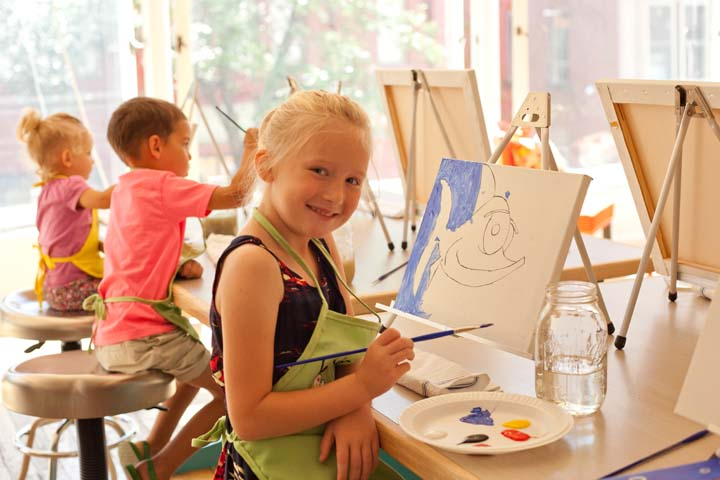
Use Multi-Step Projects
Once your preschool art center routines are solid, introduce multi-step projects that stretch over a few days. For example:
- Day 1: Sketch and outline a drawing (e.g., how to draw Wonder Woman)
- Day 2: Add color and detail
- Day 3: Create a background or collage frame
- Day 4: Present and reflect
Multi-day art builds patience and allows children to deepen their focus. It also teaches them that creativity doesn’t always happen in one sitting—a powerful lesson at any age.
Art Books and Stories
Adding books to your preschool art center is one of the simplest ways to inspire imagination, spark discussion, and introduce new ideas. Storybooks with strong visual elements can help children connect emotions, colors, characters, and actions to their creative projects. The combination of literacy and art strengthens comprehension, expression, and vocabulary, turning your preschool art center into a fully integrated learning hub.
Choose Books That Spark Imagination
Select picture books with vivid illustrations, simple storylines, and characters children can relate to. These books don’t need to be about art specifically—they need to ignite curiosity. Great choices include:
- Books about animals, followed by drawing prompts like easy animal drawing for kids
- Books featuring castles or fairy tales, paired with how to draw an easy castle
- Books about family members, leading to activities like how to draw grandpa or drawing of a man and a woman
Even a funny or emotional story can help a child think, “I want to make that!”—and that’s precisely the response you want in a preschool art center.
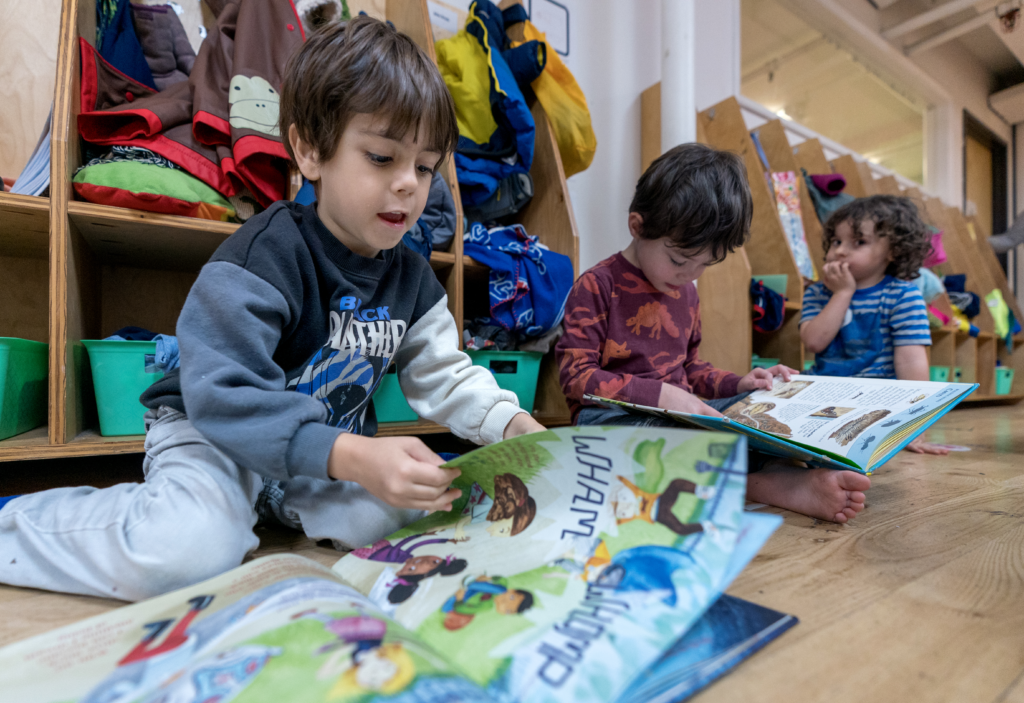
Build a “Read and Create” Shelf
Create a small shelf or bin within your preschool art center labeled “Read & Create.” Place 3–5 rotating books each week with related art invitations or drawing prompts next to them.
Having a small reading corner inside the preschool art center also supports quieter students who may prefer starting with a story before jumping into an activity.
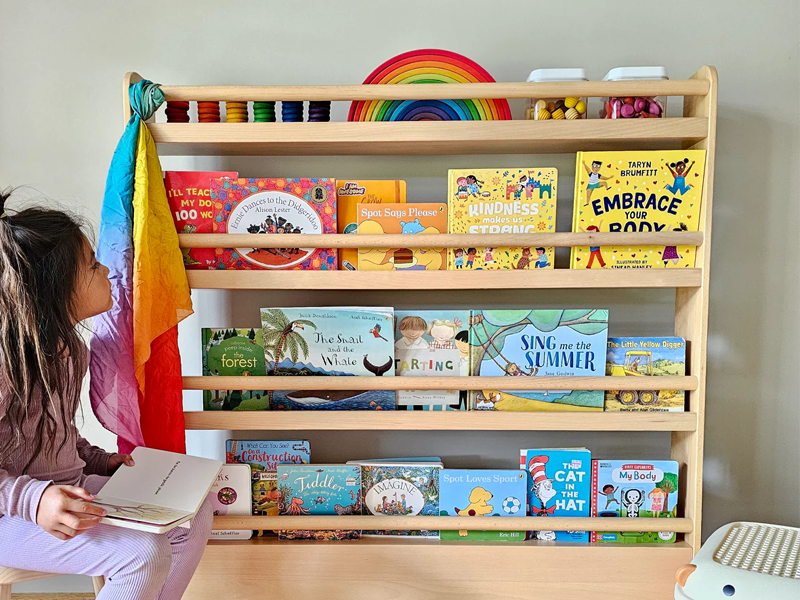
Preschool Art Center Rules
Establishing clear and consistent rules is essential for maintaining a functional, calm, and creative preschool art center. When children understand the expectations, they can work more independently, treat materials respectfully, and clean up without constant reminders. Rules also support safety and help children feel confident navigating the space on their own.
Your preschool art center rules don’t need to be complicated—but they do need to be visible, consistent, and practiced regularly. A well-run art center starts with structure.
Display Rules Where Children Can See Them
Every preschool art center should have a simple rules chart posted at child height. Use large font and visual icons to help non-readers. Stick to 3–5 core rules that can be applied every day. Examples might include:
- Use quiet voices while working
- Stay at your art center until the timer rings
- Use only what you need
- Return materials to the correct bin
- Clean up your space before you leave
You can also display a “Before You Leave” checklist at each workstation to remind children of their responsibilities.
Model the Rules Through Practice
The best way to teach preschool art center rules is by modeling them daily, especially in the first weeks of school. Don’t just tell children to clean up—show them how. For example:
- Demonstrate how to wash brushes and place them in the drying cup
- Show how to roll glue sticks down and cap them tightly
- Practice pushing in chairs and wiping down the table after a painting session
Role-playing art center routines in small groups helps children internalize the expectations and makes transitions smoother over time.
Reinforce Positive Habits
Praise goes a long way in encouraging children to follow routines. Catch them in the act of doing the right thing: “I love how you used just one piece of paper,” or “Great job remembering to close your paint cup.” A well-run preschool art center isn’t about perfection—it’s about helping kids build responsibility and pride in their workspace.
Consider assigning small classroom jobs to rotate weekly:
- Supply Checker
- Smock Organizer
- Art Table Cleaner
These responsibilities reinforce ownership and make children feel like valued members of the class.
Set Limits for Group Size
To keep the preschool art center focused and productive, it’s important to limit how many children can use the space at once. Depending on your setup, 4–6 children is typically ideal. Too many kids at one time often leads to crowding, conflict, or rushed work.
Use name tags, colored clothespins, or center cards to show who’s “in” and who needs to wait for the next rotation. Setting these boundaries helps create a calmer, more respectful environment.
Use Timers to Guide Rotations
In a structured preschool art center, children should know how long they have to work before switching activities. A visual timer, bell, or soft music cue can help signal transitions. Make sure to give a 5-minute warning before the time is up so children can finish their artwork and begin cleanup. Over time, the routine becomes automatic, and your art center stays organized without stress.
A thriving preschool art center isn’t just stocked with good materials—it’s built on intense routines and child-led independence. Clear rules, consistent modeling, and thoughtful scheduling turn the art center into a space where young artists can thrive, creatively and respectfully.
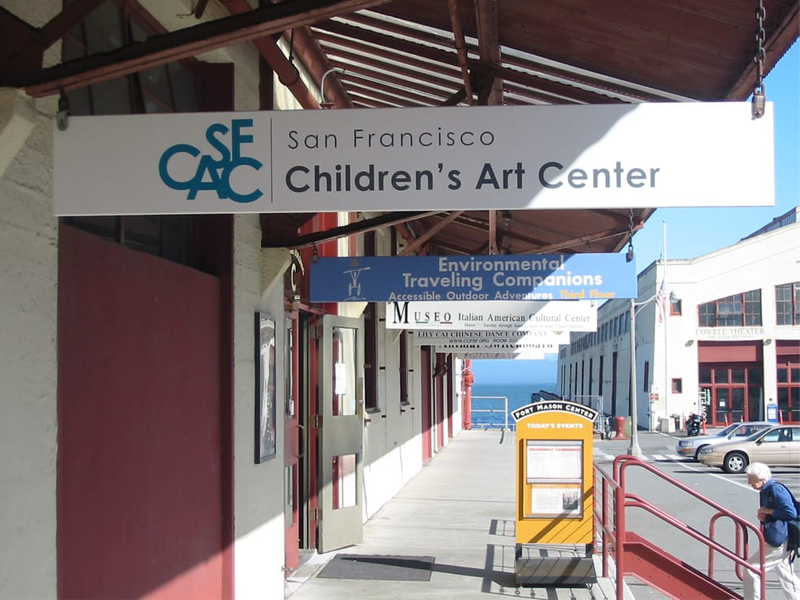
Role of the Teacher in the Art Center
A well-functioning preschool art center may look like it runs itself, but behind the scenes, a skilled teacher plays a vital role in making that magic happen. From preparing materials to supporting individual growth, your presence in the art center helps ensure that it’s not just a place for creativity but also a space for learning, confidence-building, and meaningful connection.
Prepare the Environment for Independence
One of your most significant responsibilities is to set up the preschool art center in a way that supports child-led exploration. That means:
- Keeping materials well-organized and within reach
- Labeling everything clearly with words and pictures
- Rotating supplies and prompts regularly to keep interest high
- Ensuring that the workspace is clean, safe, and inviting
When your setup is thoughtful, children can enter the art center, make choices, and work independently with confidence.
Observe, Support, and Step Back
The best teaching in the preschool art center often happens quietly. You don’t need to lead a formal art lesson every day—instead, observe what the children are doing. Watch how they hold scissors, how they problem-solve, or how they talk about their drawings. Step in with gentle guidance only when needed, and let their ideas drive the activity.
Some children may need extra help, especially those with limited motor skills. In those moments, you might model how to hold a brush or show how to glue a collage without taking over the project. The goal is to guide without directing, support without interfering.
Encourage Reflection and Sharing
A powerful extension of any preschool art center is encouraging children to reflect on what they’ve created. You can do this during transitions or end-of-day group time by asking questions like:
- “What part of your art are you proud of today?”
- “What was tricky? What did you try?”
- “What do you want to make next time?”
You can also create a “gallery walk” moment where children show their work to each other. This builds confidence and gives them the language to talk about their own creative choices.
Conclusion
By prioritizing thoughtful design, intentional materials, and teacher support, your preschool art center can become more than a corner—it can become a cornerstone.
Behind every thriving art center is a physical setup that makes creativity possible. The right child-sized tables, easy-to-clean surfaces, low storage, and flexible stations don’t just appear—they’re chosen with intention. That’s why schools around the world, from daycares with children who need extra motor skill support to full-scale Montessori classrooms, invest in purpose-built furniture that grows with their learners. At TOP Montessoris, we understand how critical it is for the physical environment to match the developmental needs of young children. Our furniture solutions are designed to help educators turn any classroom into a space where children don’t just make art—they build confidence, solve problems, and express who they are.
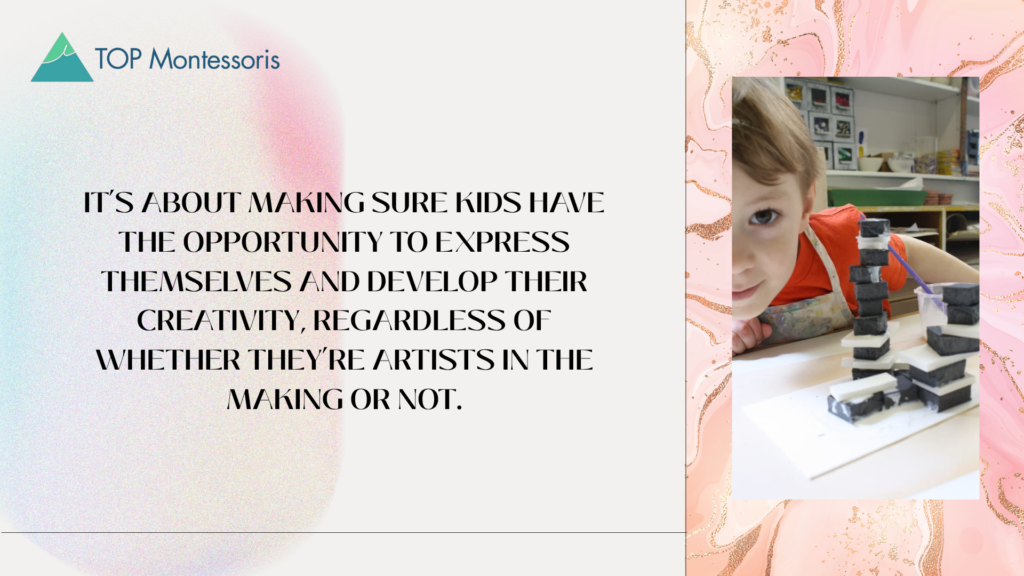
FAQs
What is the purpose of the art center in preschool?
The purpose of the preschool art center is to give young children a space where they can express themselves freely through drawing, painting, cutting, and building with different materials. It supports the development of fine motor skills, decision-making, emotional expression, and creativity—all through hands-on play. More than just a place for crafts, the art center in preschool also encourages independence, focus, and confidence as children explore their ideas in a safe, well-prepared environment.
How to display preschool children’s artwork?
Displaying artwork in your preschool art center is a powerful way to show children that their ideas and efforts are valued. Use simple methods like clothespins on a string, magnetic display boards, cork strips, or framed spaces on a dedicated “gallery wall.” Rotate work regularly to feature new creations and give each child a moment to shine. You can also create themed displays based on class projects, like a wall of castle pictures to draw or animal drawings in pencil easily, which helps build classroom pride and encourages peer recognition.

